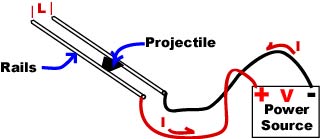An Exploration of the Physics Behind Rail Guns
Daniel Lenord
University of Alaska Fairbanks
Physics 212 Web Project, Spring 2003
Daniel Lenord
University of Alaska Fairbanks
Physics 212 Web Project, Spring 2003
| Index | Introduction | Velocity | Right Hand Rule | Bibliography | |
A rail gun in it's simplest form is a pair of conducting rails separated by a distance L and with one rail connected to the positive and one the negative side of a power source supplying voltage V and current I. A conducting projectile bridges the gap L between the rails, completing the electrical circuit. As current I flows through the rails, a magnetic field B is generated with an orientation dictated by the right hand rule and with a magnitude governed by the following equation.
B=NuI
- B=Magnetic field strength (Teslas)
- N=Number of turns in solenoid (1 in our case)
- u=1.26x10^-6 (The magnetic permeability of free space, Henries/Meter)
- I=Current through rails and projectile (Amperes)

Simple Rail Gun
F=ILB
-
F=Force on conductor (projectile, in Newtons)
-
I=Current through rails and projectile (Amperes)
-
L=Length of rail separation (Meters)
-
B=Magnetic field strength (Teslas)